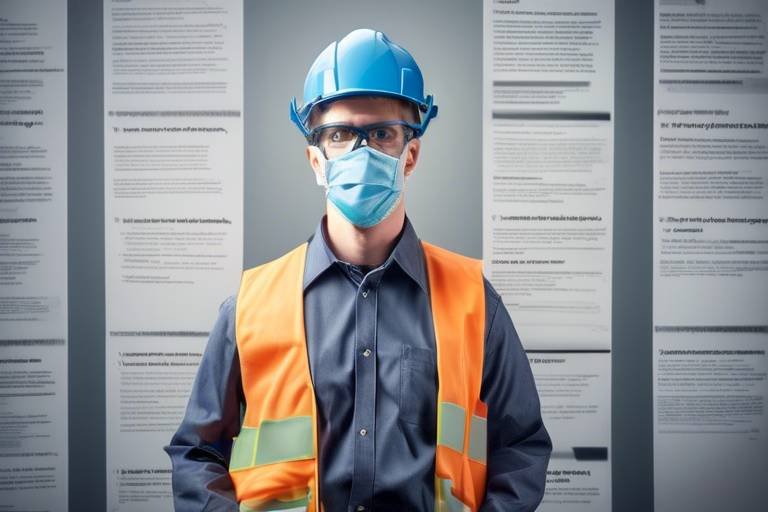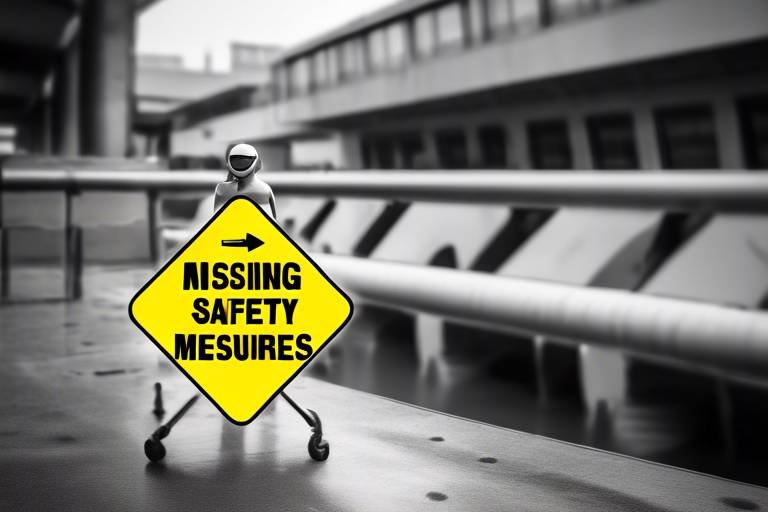Human Behavior: The Silent Factor in Safety Protocols
When we think about safety protocols, our minds often drift towards the technicalities—equipment, procedures, and regulations. However, lurking beneath the surface is a powerful, often overlooked element: human behavior. This silent factor can make or break the effectiveness of any safety initiative. Imagine a perfectly designed safety protocol that is meticulously crafted yet fails to protect because individuals choose to ignore it. That's the reality we face in various environments, from construction sites to corporate offices. The crux of the matter lies in understanding how psychological factors influence compliance, decision-making, and the overall effectiveness of safety measures.
Human behavior is a complex tapestry woven from motivations, fears, and social influences. It’s essential to peel back the layers of this complexity to uncover why individuals adhere—or fail to adhere—to safety protocols. For instance, have you ever noticed how some people seem to follow safety rules to the letter, while others treat them as mere suggestions? This disparity can be attributed to a variety of psychological factors that drive compliance. In the following sections, we will delve deeply into these factors, exploring the psychology of compliance, the nuances of risk perception, and the dynamics of group behavior. By doing so, we can shed light on how to craft safety protocols that resonate with individuals on a human level.
Furthermore, understanding the role of training and education is crucial. Effective training can transform how individuals perceive risks and adhere to safety measures. Tailored programs that resonate with the specific needs of employees can significantly enhance their understanding and promote safer behaviors. Imagine walking into a workplace where everyone is not just aware of safety rules but genuinely committed to following them. This scenario is achievable through robust training that emphasizes practical applications and real-world implications.
As we explore the intricate relationship between human behavior and safety protocols, we must also consider the impact of group dynamics. The influence of team cohesion and peer pressure cannot be overstated. When safety becomes a collective responsibility, individuals are more likely to adhere to protocols, fostering a culture of safety that benefits everyone involved. On the flip side, complacency can pose a significant barrier to compliance. Recognizing and addressing this complacency is vital for maintaining a high level of safety commitment among employees.
Ultimately, the effectiveness of safety protocols hinges on understanding and addressing human behavior. By examining the psychological factors at play, we can develop strategies that not only enhance compliance but also cultivate a lasting safety culture. As we navigate through this article, let’s keep in mind that safety is not just about rules; it’s about people. By focusing on the human element, we can create a safer environment for everyone.
- What are the main psychological factors that influence compliance with safety protocols?
- How can training improve safety compliance?
- What role does group dynamics play in safety culture?
- How can complacency be addressed in the workplace?
- Why is organizational support important for safety compliance?
Key factors include motivation, fear, social influence, and risk perception. Understanding these can help in designing better safety measures.
Effective training programs can enhance risk perception and understanding, leading to more consistent adherence to safety protocols.
Group dynamics can either encourage or discourage safety compliance. Peer pressure and team cohesion significantly influence individual behaviors.
Recognizing signs of complacency and implementing regular training and reminders can help combat this issue and maintain a commitment to safety.
Management commitment and resource allocation create an environment that prioritizes safety, encouraging employees to adhere to protocols.

The Psychology of Compliance
Understanding the psychological factors that drive compliance with safety protocols is essential for developing effective strategies. Compliance is not merely about following rules; it’s deeply rooted in human behavior, emotions, and social influences. For instance, have you ever wondered why some people strictly adhere to safety measures while others blatantly ignore them? This divergence often stems from a complex interplay of motivation, fear, and social influence.
One of the primary motivators for compliance is the desire for self-preservation. When individuals perceive a genuine threat to their safety, they are more likely to follow protocols. However, this motivation can be overshadowed by fear of repercussions or a lack of immediate consequences. In many cases, people may think, "It won’t happen to me," leading to a dangerous sense of invulnerability. This cognitive bias can create a false sense of security, where individuals underestimate risks and, consequently, fail to comply with safety measures.
Moreover, social influence plays a pivotal role in shaping behavior. Humans are inherently social creatures, and their actions are often guided by the behavior of those around them. If a person observes their peers disregarding safety protocols, they may be inclined to follow suit, thinking, "If they’re not worried, why should I be?" This phenomenon highlights the importance of fostering a strong safety culture within organizations, where adherence to safety protocols becomes the norm rather than the exception.
To further illustrate these points, consider the following table that summarizes key psychological factors affecting compliance:
| Psychological Factor | Impact on Compliance |
|---|---|
| Motivation | Increases adherence when individuals perceive a personal threat. |
| Fear | Can either encourage compliance or lead to avoidance behavior. |
| Social Influence | Peer behavior significantly affects individual choices regarding safety. |
Recognizing these psychological factors is crucial for developing effective safety strategies. Organizations need to create an environment where individuals feel motivated to comply, not just out of fear of punishment but out of a genuine understanding of the importance of safety. This can be achieved through tailored training programs that not only educate employees about the risks but also engage them emotionally, fostering a sense of responsibility towards their own safety and that of their colleagues.
In conclusion, the psychology of compliance is a multifaceted issue that requires a deep understanding of human behavior. By addressing the underlying motivations and influences that affect adherence to safety protocols, organizations can develop more effective strategies that resonate with individuals on a personal level. This not only enhances safety but also cultivates a culture of compliance that can withstand the test of time.
- What are the main psychological factors influencing compliance? The main factors include motivation, fear, and social influence.
- How can organizations improve compliance? By fostering a strong safety culture and providing tailored training programs.
- Why do people underestimate risks? Cognitive biases and a false sense of security often lead individuals to believe that "it won't happen to them."

Risk Perception and Decision-Making
When it comes to safety, risk perception is like the lens through which we view potential dangers. It's fascinating how our brains work—sometimes, they play tricks on us, leading us to underestimate risks that are very real. Imagine walking through a dark alley at night; your gut tells you to be cautious, but your mind might convince you that everything is fine. This phenomenon is not just limited to personal experiences; it significantly impacts how individuals make decisions regarding safety protocols in various environments, from workplaces to public spaces.
Cognitive biases and heuristics are the culprits behind this skewed perception. For example, the availability heuristic suggests that people judge the likelihood of an event based on how easily examples come to mind. If someone has recently heard about a workplace accident, they may overestimate the risk of similar incidents occurring in their environment. Conversely, if they haven't encountered any problems, they might dismiss safety protocols as unnecessary. This inconsistency can lead to dangerous outcomes, as individuals may not adhere to safety measures simply because they don't perceive the associated risks accurately.
Furthermore, the illusion of control can play a significant role in decision-making. People often believe they have more control over their safety than they actually do. This sense of invulnerability can lead to risky behaviors, such as neglecting to wear protective gear or skipping safety training sessions. It's like standing on the edge of a cliff, feeling confident that you won't fall, but forgetting that the ground beneath you is unstable. This overconfidence can be detrimental, both to the individual and to the organization as a whole.
To illustrate the impact of risk perception on decision-making, consider the following table that outlines different cognitive biases affecting safety compliance:
| Cognitive Bias | Description | Impact on Safety |
|---|---|---|
| Availability Heuristic | Judging the likelihood of events based on recent experiences or examples. | May lead to overestimating or underestimating risks. |
| Illusion of Control | Believing one has more control over safety outcomes than is realistic. | Can result in risky behaviors and neglect of safety measures. |
| Optimism Bias | Assuming that bad things are less likely to happen to oneself compared to others. | May cause individuals to disregard safety protocols. |
Understanding these biases is crucial for developing effective safety protocols. Organizations must not only implement safety measures but also educate their employees about the psychological factors influencing their perceptions of risk. By fostering an awareness of these biases, companies can encourage a culture of safety that transcends mere compliance. It's about creating an environment where individuals recognize the importance of adhering to safety protocols, not just because they have to, but because they genuinely understand the risks involved.
In conclusion, risk perception is a complex interplay of psychological factors that significantly influences decision-making regarding safety. By acknowledging and addressing these cognitive biases, organizations can improve compliance with safety protocols and ultimately create a safer working environment for everyone. After all, safety is not just about rules and regulations; it's about understanding the human element that drives behavior.
- What is risk perception? Risk perception refers to how individuals interpret and evaluate potential dangers in their environment, which can influence their decision-making regarding safety.
- How do cognitive biases affect safety compliance? Cognitive biases can lead individuals to underestimate risks or feel overly confident, resulting in non-compliance with safety protocols.
- What can organizations do to improve risk perception? Organizations can provide training and education about cognitive biases, encouraging employees to recognize and understand the risks associated with their actions.
- Why is understanding human behavior important for safety protocols? Understanding human behavior helps organizations develop more effective safety measures that resonate with employees, leading to better compliance and a stronger safety culture.

The Role of Training and Education
When it comes to safety protocols, the role of training and education cannot be overstated. Think of training as the foundation of a sturdy building; without it, everything else can come crashing down. Effective training programs are designed not just to inform but to engage participants, ensuring they understand the importance of safety measures and how to implement them in their daily routines. This engagement is crucial because it directly influences an individual's risk perception and compliance with safety protocols.
Research indicates that individuals who receive tailored training are more likely to recognize hazards and respond appropriately. For instance, a study conducted in manufacturing settings revealed that employees who underwent hands-on training were able to identify potential risks more effectively than those who only attended lectures. This highlights the need for training that goes beyond theoretical knowledge and incorporates practical applications. By simulating real-world scenarios, trainers can help employees develop the necessary skills to make informed decisions in high-pressure situations.
Moreover, education plays a pivotal role in shaping attitudes towards safety. When employees understand the “why” behind safety protocols, they are more likely to adhere to them. For example, if workers grasp the serious consequences of neglecting safety measures—such as accidents that could lead to injury or even loss of life—they are more inclined to take these protocols seriously. This psychological shift can be achieved through various educational methods, including workshops, e-learning modules, and interactive discussions.
To illustrate the significance of effective training, consider the following table that outlines key components of successful training programs:
| Component | Description |
|---|---|
| Engagement | Interactive activities that involve participants actively. |
| Relevance | Content that relates directly to the participants' job roles. |
| Feedback | Opportunities for participants to ask questions and receive constructive feedback. |
| Follow-Up | Regular check-ins to reinforce learning and address ongoing concerns. |
Incorporating these components into training programs can significantly enhance their effectiveness. Furthermore, providing ongoing education ensures that safety protocols evolve with changing environments and technologies. This continuous learning approach not only keeps employees informed but also fosters a culture of safety where individuals feel empowered to voice concerns and suggest improvements.
Ultimately, the combination of training and education creates a robust safety culture that prioritizes compliance and proactive behavior. When employees are well-informed and equipped with the right skills, they become not just followers of safety protocols but advocates for a safer workplace. This shift from mere compliance to active engagement is crucial for reducing incidents and promoting a long-lasting commitment to safety. So, let’s invest in our people through comprehensive training and education, because when it comes to safety, knowledge truly is power!
- What is the importance of training in safety protocols? Training equips employees with the necessary skills and knowledge to recognize and respond to safety risks effectively.
- How can education influence compliance with safety measures? Education helps employees understand the reasons behind safety protocols, making them more likely to adhere to them.
- What are some effective training methods for safety? Hands-on training, simulations, and interactive workshops are effective methods that engage participants and improve learning outcomes.

Behavioral Modeling Techniques
When it comes to enhancing safety protocols, emerge as a game-changer. Imagine walking into a workplace where safety is not just a rule but a culture, a shared value that everyone embraces. This is where behavioral modeling comes into play. It involves learning by observing others—essentially, we mimic the actions of those around us. When employees see their peers adhering to safety measures, it creates a ripple effect, encouraging similar behavior throughout the organization.
Think of it this way: if you were to watch a seasoned worker donning their safety gear correctly, you’re more likely to follow suit. This powerful form of social learning taps into our innate desire to fit in and be accepted by our peers. It’s not just about following rules; it’s about being part of a community that prioritizes safety. As a result, organizations can foster a stronger safety culture where individuals feel empowered to act responsibly.
Moreover, behavioral modeling can be particularly effective when combined with structured training programs. For instance, consider a scenario where new employees are paired with experienced mentors. During these interactions, the mentors can demonstrate safe practices, explain the rationale behind them, and answer any questions. This not only provides a clear example of expected behavior but also builds a supportive environment where learning is encouraged.
To maximize the effectiveness of behavioral modeling, organizations should consider the following strategies:
- Peer Observations: Encourage employees to observe one another and provide constructive feedback. This not only reinforces safe practices but also fosters a sense of accountability.
- Role-Playing Exercises: Incorporate role-playing scenarios in training sessions where employees can practice responding to safety challenges in a controlled environment.
- Recognition Programs: Implement programs that recognize and reward safe behavior. This not only motivates individuals but also highlights the importance of modeling safety for others.
In conclusion, behavioral modeling techniques are not just about teaching safety; they are about cultivating a mindset where safety becomes second nature. By leveraging the power of observation and social influence, organizations can create an environment where safe practices are not just expected but celebrated. This approach not only enhances compliance but also strengthens the overall safety culture, making workplaces safer for everyone.
Q1: What are behavioral modeling techniques?
A1: Behavioral modeling techniques involve learning safe behaviors by observing and imitating others, particularly peers who demonstrate compliance with safety protocols.
Q2: How can organizations implement behavioral modeling?
A2: Organizations can implement behavioral modeling through peer observations, role-playing exercises, and recognition programs that highlight safe practices.
Q3: Why is behavioral modeling effective in promoting safety?
A3: It leverages social influence, encouraging individuals to adopt safe behaviors by seeing their peers do the same, thus fostering a culture of safety.

Feedback Mechanisms
Feedback mechanisms are essential components in the structure of safety protocols. They serve as the bridge between compliance and understanding, ensuring that individuals are not only aware of safety measures but also motivated to adhere to them. When we think about feedback, it’s akin to the GPS in our cars—without it, we might veer off course, unaware of the potential hazards ahead. In safety contexts, feedback can take many forms, from verbal cues to formal evaluations, and each type plays a significant role in reinforcing safe behaviors.
One effective feedback mechanism is real-time feedback, which provides immediate insights into an individual's actions. For instance, if a worker is observed not wearing protective gear, a supervisor can intervene right away, emphasizing the importance of compliance. This immediate response not only corrects the behavior but also serves as a reminder of the overarching safety culture. In contrast, delayed feedback—such as a monthly safety report—can sometimes lead to a disconnect between actions and consequences. People may forget the specifics of their behavior, making it harder for them to connect the dots.
Moreover, feedback can be both formal and informal. Formal feedback often comes in the form of structured reviews or performance appraisals, while informal feedback might be casual conversations among coworkers. Both forms are crucial; informal feedback can create a more relaxed atmosphere where individuals feel comfortable discussing safety concerns. In fact, fostering an environment where employees can share their observations and experiences openly can lead to a more robust safety culture.
To illustrate the effectiveness of feedback mechanisms, consider the following table that outlines different types of feedback and their impact on safety compliance:
| Type of Feedback | Description | Impact on Compliance |
|---|---|---|
| Real-time Feedback | Immediate correction of unsafe behaviors during tasks. | High - promotes instant awareness and correction. |
| Formal Evaluations | Structured reviews conducted periodically. | Medium - provides a comprehensive overview but may lack immediacy. |
| Peer Feedback | Informal discussions among coworkers about safety practices. | High - encourages a supportive environment and shared responsibility. |
In addition, utilizing technology can enhance feedback mechanisms. Many organizations are now employing mobile apps that allow employees to report safety issues in real-time, receive alerts about unsafe practices, and access educational resources. This tech-savvy approach not only streamlines communication but also empowers employees to take ownership of their safety and the safety of their colleagues.
Ultimately, the effectiveness of feedback mechanisms hinges on their implementation. It’s not just about providing feedback; it’s about creating a culture where feedback is valued and acted upon. Organizations must train their leaders to deliver constructive feedback effectively and encourage open dialogues about safety. When employees feel that their input is valued, they are more likely to engage with safety protocols actively, leading to a safer work environment for everyone.
- What is the role of feedback in safety protocols?
Feedback helps to reinforce safe behaviors, correct unsafe practices, and promote a culture of safety awareness. - How can organizations implement effective feedback mechanisms?
Organizations can use a combination of real-time feedback, formal evaluations, and peer discussions, along with technology to enhance communication. - Why is real-time feedback more effective than delayed feedback?
Real-time feedback provides immediate correction, which helps individuals connect their actions with safety outcomes more effectively.

Group Dynamics and Safety Culture
When it comes to safety protocols, the impact of group dynamics cannot be overstated. Think about it: have you ever noticed how your behavior changes when you're part of a group? Whether it's at work, in a social setting, or even during a sports game, the influence of those around you can shape your actions in profound ways. In the context of safety, this means that the culture within a team or organization plays a pivotal role in determining how well safety protocols are followed.
One of the key elements of group dynamics is team cohesion. When team members feel a sense of belonging and trust, they are more likely to communicate openly about safety concerns and adhere to protocols. Conversely, in a fractured team environment, where individuals feel isolated or unsupported, compliance can suffer. This is where leadership comes into play. Leaders who foster an inclusive and supportive culture can significantly enhance safety outcomes. They can create an environment where individuals feel empowered to speak up about unsafe practices without fear of reprisal.
Moreover, peer pressure is another critical factor that influences safety culture. It can be a double-edged sword. On one hand, positive peer pressure can encourage individuals to follow safety protocols diligently. For instance, if everyone in a team wears their personal protective equipment (PPE), new members are likely to adopt the same behavior. On the other hand, negative peer pressure can lead to risky behaviors, such as skipping safety measures to fit in or meet perceived expectations. This highlights the importance of establishing a strong safety culture that promotes accountability and encourages team members to look out for one another.
To illustrate the relationship between group dynamics and safety culture, consider the following table:
| Group Dynamics Factor | Impact on Safety Culture |
|---|---|
| Team Cohesion | Enhances communication and compliance with safety protocols. |
| Peer Pressure | Can either promote adherence or lead to risky behaviors. |
| Leadership Support | Fosters an environment where safety is prioritized and valued. |
In addition to these factors, open communication is essential in cultivating a robust safety culture. Teams that regularly discuss safety issues and share experiences are better equipped to identify potential hazards and implement effective solutions. Encouraging regular safety meetings or informal check-ins can help keep safety at the forefront of everyone's minds. This creates a shared responsibility for safety, making it a collective goal rather than an individual one.
Ultimately, the interplay between group dynamics and safety culture underscores the importance of fostering a positive environment where safety is a shared value. By recognizing the influence of team interactions and promoting a culture of safety, organizations can significantly enhance compliance with safety protocols. This not only protects individuals but also contributes to a more productive and harmonious workplace.
- What is group dynamics? Group dynamics refers to the interactions and behaviors of individuals within a group, which can influence their actions and decisions.
- How does team cohesion affect safety? High team cohesion fosters trust and open communication, leading to better adherence to safety protocols.
- What role does leadership play in safety culture? Leadership is crucial in setting the tone for safety culture, providing support, and encouraging compliance among team members.
- Can peer pressure be positive in a safety context? Yes, positive peer pressure can encourage individuals to follow safety protocols and practices.

Barriers to Compliance
When it comes to safety protocols, understanding the barriers to compliance is like peering into a foggy mirror; it requires clarity and insight. Many organizations often find themselves grappling with obstacles that hinder adherence to established safety measures. These barriers can range from complacency and lack of resources to deeply ingrained aspects of organizational culture. Recognizing these elements is crucial for any organization aiming to enhance its safety protocols.
One of the most insidious barriers is complacency. This can creep in when individuals believe that safety measures are unnecessary or that accidents won't happen to them. It’s akin to driving on a familiar road while ignoring the speed limit signs; the more comfortable you feel, the more likely you are to let your guard down. Complacency can lead to a dangerous underestimation of risks, causing employees to overlook safety protocols that are designed to protect them.
Moreover, the lack of resources can significantly impede compliance. Imagine trying to bake a cake without the right ingredients; it just won’t turn out well. Similarly, if employees don’t have access to the necessary tools, training, or time to follow safety protocols, they are less likely to adhere to them. For instance, if a factory lacks proper safety gear, workers might choose to forgo it, believing it’s more efficient to work without it. This not only jeopardizes their safety but also undermines the entire safety culture within the organization.
Another critical barrier is the organizational culture. If a company fosters a culture where safety is viewed as secondary to productivity, employees will inevitably prioritize getting the job done over following safety protocols. This is often seen in environments where management pressures workers to meet deadlines at the expense of safety. In such cases, employees may feel that reporting safety violations or taking time to follow protocols could jeopardize their job security or reputation among peers.
To illustrate how these barriers manifest, consider the following table that summarizes common obstacles to compliance:
| Barrier | Description |
|---|---|
| Complacency | Overconfidence in safety and a false sense of security leading to neglect of protocols. |
| Lack of Resources | Insufficient tools, training, or time allocated for adhering to safety measures. |
| Organizational Culture | A workplace environment that prioritizes productivity over safety compliance. |
Addressing these barriers requires a multifaceted approach. Organizations must actively work to cultivate a safety-first culture, where compliance is viewed as a shared responsibility rather than just a set of rules to follow. This involves engaging employees in safety discussions and encouraging them to voice their concerns without fear of retribution. When employees feel valued and heard, they are more likely to commit to safety protocols.
In conclusion, barriers to compliance are not just simple hurdles; they are complex challenges that require thoughtful strategies to overcome. By recognizing complacency, addressing resource shortages, and fostering a positive safety culture, organizations can significantly improve adherence to safety protocols. Remember, safety is a journey, not just a destination, and it starts with understanding the roadblocks that lie ahead.
- What are the most common barriers to compliance with safety protocols? Complacency, lack of resources, and organizational culture are among the most prevalent barriers.
- How can organizations combat complacency? Regular training, awareness campaigns, and a culture of open communication can help address complacency.
- Why is organizational culture important for safety compliance? A positive culture prioritizes safety, encouraging employees to adhere to protocols without fear of negative consequences.

Addressing Complacency
Complacency is like a sneaky thief in the night; it creeps up on us and can undermine even the most robust safety protocols. When individuals become too comfortable with their routines, they often overlook potential hazards, leading to dangerous situations. To combat this, it’s essential to recognize the signs of complacency early on. Are employees skipping safety checks? Are they ignoring protocols that once seemed vital? These behaviors are red flags indicating that complacency may be setting in.
One effective strategy to address complacency is to foster a culture of continuous improvement. This means regularly revisiting safety protocols and encouraging employees to provide feedback on their effectiveness. When team members feel empowered to voice their concerns, they are more likely to stay engaged and vigilant. Moreover, incorporating regular safety drills can keep everyone on their toes. Much like athletes practice their game, these drills can help employees remain familiar with safety measures and reinforce their importance.
Another approach is to implement a reward system that recognizes safe behaviors. Acknowledging individuals or teams who consistently adhere to safety protocols can create a positive feedback loop. For instance, consider a monthly recognition program where employees are highlighted for their commitment to safety. This not only motivates others to follow suit but also reinforces the idea that safety is a shared responsibility.
Additionally, providing ongoing training is crucial in combating complacency. Just as technology evolves, so do best practices in safety. Regular training sessions can refresh employees' knowledge and skills, ensuring they remain aware of potential risks. Here’s a simple table to illustrate how different training approaches can impact complacency:
| Training Approach | Impact on Complacency |
|---|---|
| Annual Safety Refresher Courses | Reinforces knowledge and awareness |
| Interactive Workshops | Engages employees and encourages participation |
| On-the-Job Training | Provides real-time feedback and application |
Ultimately, addressing complacency requires a multi-faceted approach that combines awareness, recognition, and continuous learning. By creating an environment that values safety and encourages open communication, organizations can significantly reduce the risk of complacency. Remember, complacency is not just an individual issue; it can affect the entire team. So, let’s keep the conversation going and ensure that safety remains a top priority!
- What are the signs of complacency in the workplace? Look for behaviors like skipping safety checks, ignoring protocols, or a general lack of awareness about potential hazards.
- How can we encourage employees to stay vigilant about safety? Foster a culture of continuous improvement, provide regular training, and implement recognition programs for safe behaviors.
- Why is complacency a significant issue in safety protocols? Complacency can lead to dangerous oversights and increase the risk of accidents, making it crucial to address proactively.

Organizational Support Systems
When it comes to fostering a culture of safety within an organization, the role of cannot be overstated. These systems are the backbone of any safety protocol, providing the necessary resources, training, and motivation for employees to adhere to safety measures. Imagine walking into a workplace where safety is not just a set of rules but a deeply ingrained value supported by management. This is the kind of environment that organizational support can create, where safety becomes second nature to everyone involved.
One of the key elements of organizational support is management commitment. When leaders prioritize safety and demonstrate their dedication through actions, it sends a powerful message to employees. For instance, regular safety meetings, transparent communication about safety issues, and visible involvement in safety initiatives can significantly enhance the perception of safety within the organization. Employees are more likely to comply with safety protocols when they see their leaders genuinely invested in these practices.
Furthermore, resource allocation is critical in ensuring that safety protocols are not just theoretical concepts but practical realities. Organizations must allocate sufficient resources—be it training budgets, safety equipment, or time for safety drills—to ensure that employees are well-equipped to follow safety protocols. A lack of resources can lead to frustration and, ultimately, non-compliance. For example, if employees are expected to wear protective gear but the organization fails to provide adequate supplies, they may be less inclined to comply with safety measures, thinking, “What’s the point?”
Moreover, effective communication channels are essential in reinforcing safety protocols. Organizations should establish clear lines of communication where employees feel comfortable reporting safety concerns or suggesting improvements. This open dialogue not only empowers employees but also fosters a sense of community and shared responsibility for safety. When individuals feel heard and valued, they are more likely to take ownership of their safety practices and encourage their peers to do the same.
In addition to these factors, organizations should implement feedback mechanisms that allow for continuous improvement of safety protocols. Regularly soliciting feedback from employees about safety practices can uncover blind spots and lead to better compliance. For instance, conducting anonymous surveys or holding focus groups can provide valuable insights into how safety protocols are perceived and followed. This not only helps in identifying areas for improvement but also shows employees that their opinions matter, which can boost morale and compliance.
To illustrate the impact of organizational support systems, consider the following table that outlines the key components of effective support and their benefits:
| Component | Description | Benefits |
|---|---|---|
| Management Commitment | Visible involvement of leadership in safety initiatives. | Increased employee trust and compliance. |
| Resource Allocation | Provision of necessary tools and training for safety. | Enhanced ability to adhere to safety protocols. |
| Communication Channels | Open lines for reporting and discussing safety issues. | Empowerment of employees and improved safety culture. |
| Feedback Mechanisms | Regularly soliciting and acting on employee feedback. | Continuous improvement of safety practices. |
In conclusion, organizational support systems are vital for cultivating a robust safety culture. By ensuring management commitment, allocating appropriate resources, fostering open communication, and implementing feedback mechanisms, organizations can significantly enhance compliance with safety protocols. Remember, safety is a shared responsibility, and when organizations invest in their people, they pave the way for a safer, more productive workplace.
- What is the role of management in safety compliance?
Management plays a crucial role by demonstrating commitment to safety, providing necessary resources, and fostering open communication. - How can feedback improve safety protocols?
Feedback helps identify areas for improvement and encourages a culture of continuous learning and adaptation. - Why is resource allocation important for safety?
Without adequate resources, employees may struggle to adhere to safety protocols, leading to increased risks and potential accidents.
Frequently Asked Questions
- What is the role of human behavior in safety protocols?
Human behavior plays a critical role in the effectiveness of safety protocols. It influences how individuals perceive risks, comply with safety measures, and make decisions in potentially hazardous situations. Understanding these behaviors can help organizations design better safety strategies.
- How does motivation affect compliance with safety protocols?
Motivation is a key driver of compliance. When individuals feel personally invested in safety—whether through intrinsic motivation like personal safety or extrinsic motivation such as rewards—they are more likely to adhere to safety protocols. Creating an environment that fosters motivation can significantly enhance compliance.
- What are some common barriers to compliance?
Common barriers to compliance include complacency, lack of resources, and a negative organizational culture. When employees feel that safety measures are unnecessary or when they lack the proper tools and support, adherence to safety protocols can suffer. Identifying and addressing these barriers is essential for improving safety outcomes.
- How can training improve safety compliance?
Effective training enhances understanding and promotes safer behaviors among individuals. Tailored training programs that address specific risks and include practical scenarios can significantly improve risk perception and compliance with safety protocols.
- What is behavioral modeling and how does it impact safety?
Behavioral modeling involves learning by observing the safe behaviors of others. When individuals see their peers practicing safety protocols, they are more likely to imitate those behaviors, which can lead to a stronger safety culture within the organization.
- Why is feedback important in safety protocols?
Feedback mechanisms are crucial for reinforcing safe behaviors. Providing constructive feedback helps individuals understand their performance regarding safety measures and encourages continuous improvement. It creates a loop of communication that enhances overall safety compliance.
- How do group dynamics affect safety culture?
Group dynamics, including team cohesion and peer pressure, significantly influence individual behavior towards safety. A supportive team environment can encourage adherence to safety protocols, while negative group dynamics can lead to risky behaviors. Fostering a positive safety culture is essential for effective compliance.
- What strategies can combat complacency in safety practices?
To combat complacency, organizations can implement regular safety training, conduct safety audits, and create awareness campaigns. Engaging employees in discussions about safety and recognizing their contributions can also help maintain a high level of commitment to safety protocols.
- How does organizational support influence safety compliance?
Organizational support, such as management commitment and adequate resource allocation, plays a significant role in fostering compliance with safety protocols. When employees see that their organization prioritizes safety, they are more likely to follow established protocols and engage in safe practices.



















